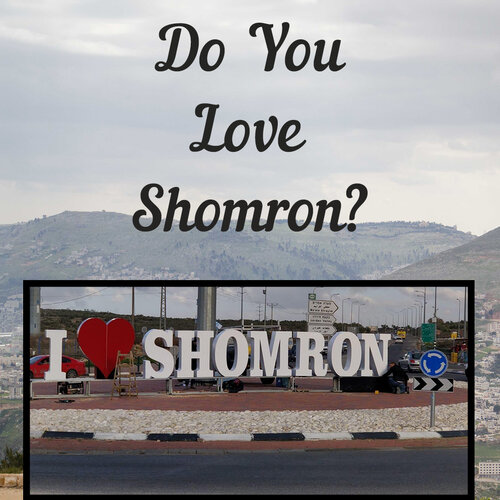Do you love Shomron? Did you know some people hate Shomron? If you’re wondering what the Shomron even is, let me explain. First though, can you guess where this beautiful sign is located? That’s right! It was unveiled this week in Israel’s biblical heartland, in the heart of the Samaria mountains!
This week, Yossi Dagan, the head of the Shomron (Samaria) Regional Council unveiled a sign that is eight feet tall and nearly forty feet long in the middle of a roundabout at a key intersection in Judea and Samaria called Tapuach Junction. Tapuach in Hebrew means apple, and the junction sits just next to the Jewish community of Kfar Tapuach (Apple Village), which is named after the same territory mentioned in the Bible in the book of Joshua in reference to the children of Israel settling the land of Canaan.
Tapuach Junction stands along Highway 60, also known as the ancient Road of the Patriarchs. If one drives east from the junction, you would reach the Jordan Valley within 30 minutes. If you travel west, you would reach the Mediterranean in less than an hour. South takes you to Jerusalem in 40 minutes, and north goes to the Mt of Blessing, just beside Shechem.
At the inauguration of the beautiful, “I Love Shomron” sign, hundreds of drivers stopped at the intersection and applauded. Yossi Dagan, head of the Samaria Regional Council, said:
“We made a significant step today in the Samaria tourism revolution; it’s another step in transforming Samaria into a global tourism power – we’re on the way to millions of tourists in Samaria. Tapuach Junction is the gateway to Samaria, the south and the east and is one of the central strategic junctions in the State of Israel, with much tourist movement to tourist sites. In addition, the intersection has the Trans-Samaria Highway 5 reaching Route 90 to the Jordan Valley and also the Fathers’ Highway Route 60, connecting to Tapuach Junction.”
He added, “The sign that is similar to those in major cities in the world is a symbol of Samaria’s centrality and importance in the State of Israel. The heart of the country that dominates the entire State of Israel and the entire coastal plain from its height, is where a significant portion of the Bible stories happened deserves a presentation just as Jerusalem, Tel Aviv, and Paris. We invite the general public to come, walk, enjoy, and of course take pictures.”
So back to our first question – what is Shomron? Shomron is a hebrew word for Samaria, which is the area from just north of Shiloh all the way north of Har Bracha (Mt. of Blessing/Gerizim) and Elon Moreh (Genesis 12). It encompasses the biblical territory of Samaria, and today is made up of the Samaria Regional Council, which is a territorial area similar to a county in the United States.
Biblically, Samaria is referenced numerous times in the Old and New Testaments. Biblical prophecies speak of the mountains of Israel many, many times. Here are a few examples:
“But you, O mountains of Israel, you shall shoot forth your branches and yield your fruit to My people Israel, for they are about to come.” (Ezekiel 36:8)
“How beautiful upon the mountains are the feet of him who brings good news, who proclaims peace, who brings glad tidings of good things, who proclaims salvation, who says to Zion,
‘Your God reigns’!” (Isaiah 52:7)
When mountains are referenced in the Bible, typically it is referring to Judea and Samaria, which is a mountain range running through central Israel.
Jeremiah 31:5 references Samaria directly, a prophecy which we are seeing fulfilled today:
“You shall yet plant vines on the mountains of Samaria; the planters shall plant and eat them as ordinary food.”
In the New Testament, there are numerous stories of Yeshua (Jesus) traveling from the Galilee to Jerusalem through Samaria. Typically, pilgrims would have traveled through the Jordan Valley to reach Jerusalem, since going through Samaria brought them in close proximity to the Samaritans, who were hostile to the Jewish people. However, Yeshua reached out to the Samaritans, with the most famous story being the story of the woman at the well. This story took place on the Mt. of Blessing, in the heart of Samaria.
Did you know that more than 80% of the Bible was either written or occurred in Judea and Samaria?
Tourism to Samaria has slowly been growing over the years. Today, there are more opportunities than ever to visit the rich history, culture, and sites that are connected to the Jewish and Christian faiths, and the opportunities are still expanding. The beautiful, “I love Shomron” sign placed in the heart of Samaria is just the latest example.
So whether you’re planning to come on a tour to Israel in 2020, or go deeper with a volunteer opportunity or personal visit, make sure to include Judea and Samaria in your plans. You won’t be disappointed. And make sure to visit Tapuach Junction and take a photo with the new “I Love Shomron” sign!

